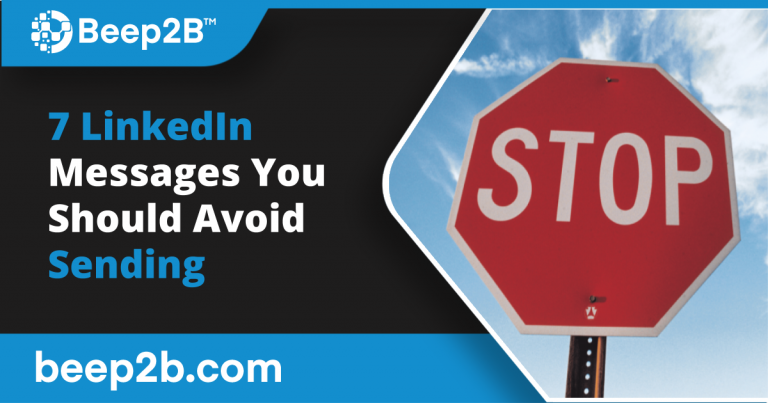How often does a message drop into your LinkedIn inbox that you would classify as spam?
The issue is the there are no hard and fast rules for LinkedIn messaging etiquette so most people don’t even know when what they’re sending appears spammy to the recipient.
We’ve compiled a list of the biggest mistakes you can make when messaging potential prospects or a future employer on LinkedIn which can actually hinder your success on the platform.
1. An Un-Personalized Connection Request
LinkedIn’s default is an invitation to connect without any accompanying message – in the mobile app in particular, it’s easy to take the lazy option and just hit “Connect”.
However, unless you know someone really well, this tactic rarely works. You should take the time to personalize your invitation to give the recipient a good reason to join your network.
When a prospect receives your connection request, they have 3 options: Accept, Ignore or Report (by selecting “I don’t know this person”). If you receive too many “I don’t know this person” responses, LinkedIn could place a restriction on your account which requires an email address every time you want to send a connection request to verify that you know that person directly. This will severely hinder your ability to expand your network.
Personalizing the LinkedIn invitation message will help give your prospect a clear reason to accept your connection request and help you stand out from the majority of people who continue to under-utilize this feature.
NOTE: Connection requests can contain a maximum of 300 characters (including spaces) so keep it short and to the point.
2. Message Requesting Recommendations from People you Haven’t Worked With
Believe it or not, this is a strategy that some users are employing on the LinkedIn platform and guess what? It doesn’t work and hurts your reputation and personal brand in the process.
Unless you’ve worked directly with someone, don’t request a LinkedIn recommendation or endorsement. Even if they do accept and write something, it won’t have the same effect as a recommendation written by someone who has really benefitted from your skills and expertise and it will read as lukewarm at best.
Recommendations are important as they provide Social Proof and demonstrate to potential clients what it’s like to work with you. Today, people often make decisions based on the experiences and reviews of others.
With LinkedIn recommendations, quality definitely trumps quantity. However, in an ideal world a minimum of 5 recommendations from credible individuals is the goal.
When asking for a recommendation, it is vital to personalize your request – perhaps jogging their memory about the highlights of your work together to help them structure their review. Many people are unsure of what to write and providing them with some bullet points will increase the likelihood they’ll provide you with a recommendation.
It’s also important to ask for recommendations in a timely manner – when someone praises your work, ask there and then whether they would mind replicating it on LinkedIn as a recommendation.
3. Asking too much, too soon
Your prospects are busy. Asking them to take time out of their schedule for a call before they know who you are, what you want to talk about or how long you want to talk isn’t going to fly.
When building relationships on LinkedIn, concentrate on getting to know them and understanding their needs. Provide value and demonstrate your expertise on your niche. This will help build your credibility and only then should suggest a meeting.
4. Sales Pitches
Sending a direct sales pitch is a fast track to disgruntled connections. It’s vital that you establish a relationship before you take the plunge and pitch your offering. Instead, establish credibility and demonstrate you understand and are capable of resolving their pain points which will build the foundation for a much better pitch when the time is right.
5. “I saw you viewed my profile” Messages
When someone views your profile on LinkedIn, it’s a great idea to reach out and make a connection if they fit your target demographic.
You can see who’s viewed your profile by navigating to the “Who’s viewed my Profile” page on LinkedIn. If you are a free LinkedIn member, you will only be able to see the last 5 people who’ve looked at your profile, whereas, as a Sales Navigator user you will be able to see everyone who’s viewed your profile in the last 90 days.
However, using the sole fact someone looked at your profile as the reason for connecting with someone doesn’t quite cut it. There could be a number of reasons why they were checking out your profile so instead of addressing why they viewed your profile within your scant 300 characters, instead make the focus about why you’d like to connect with them specifically.
6. Asking for Follows on other Social Platforms
You are engaging with them on LinkedIn, so engage with them on LinkedIn. It may be that they don’t use other social media platforms, so keep the conversation in the one place you know they’re active.
As LinkedIn is the professional platform, it attracts many users who opt-out of other social media platforms such as Facebook, Instagram and Twitter. Keep the conversation on LinkedIn rather that splitting your interaction across the web.
7. Messages that are TOO friendly
Once more for those at the back: LinkedIn is the professional social network. Think about the way that your messages will be received by your connection – does it deliver value? That’s not to say you can’t demonstrate your personality, but you want to do business with these people so keep it professional!
Remember, spam is subjective. If your messages doesn’t deliver value and build a professional relationship then don’t send it!


